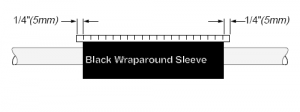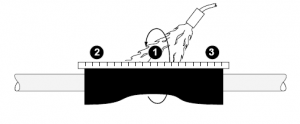GENERAL PREPARATORY WORKS
- All permanent and consumable materials shall be prepared prior to
- The following requirements shall be followed and implemented according to NEC Article 501 and 502 supplements.
- Electrical materials shall conform to all applicable requirements, standard, and specifications prior to release to be used as part of the work.
- Hand gloves and respiratory mask (3M) shall be available prior to start, for health and safety purposes.
- Manpower, equipment, tools and other logistics are ready and prepared for installation.
- Follow manufacturer recommended procedure for material handling and storage.
LV CABLE REPAIR PROCEDURE
Using an approved solvent, clean and degrease the damaged area and the cable on either side of the damage as shown. Remove any sharp points from the area to be covered with Rychem CRSM. See figure below:
Center sleeve over damage area. Mark cable as shown. Remove the release paper from the CRSM.
Butt the rails together and slide the channel over the rails. Center sleeve between marks.
Note: Channel must extend beyond the sleeve edge as shown:
Pre heat the metal channel for approximately 15 seconds. Continue shrinking at the center (1), working torch with a smooth brushing motion around the sleeve. After the center portion shrinks, work torch as before toward one end (2), then to the opposite end (3). See figure below:
Post heat the entire length, concentrating on the metal channel, until the CRSM conforms tightly to the cable, without wrinkles, and adhesive flows from each end.
This completes the installation. Discard black cloth tape and sealant.
Note: Allow to cool before moving or placing in service.
QC Inspector shall witness and conduct inspection for the complete cable repair, complete Insulation resistance and continuity test. The result shall be recorded and filed.
Use of propane or butane gas torch in heating the wrap around sleeve as per manufacturer’s instruction
SAFETY PRECAUTION FOR LV CABLE REPAIR
- Obtain necessary work permits from the concerned EPC Representative intended for the job before starting any work.
- Conduct proper preparation to include required safety equipment and tools for the commencement of the work.
- Activities shall be executed in accordance with this procedure and related standards and specifications.
- Provide warning sign and sufficient barricade on working area. Only assigned personnel will be allowed in the area to maintain a safe work environment.
- Conduct safety briefing to all working crew to remind them of all the basic safety requirements on the job to ensure safe work flow.
- All necessary personal protective equipment (PPE) shall be provided and to be worn at all times in accordance with site Safety Procedure.
- Safety harness with double lanyards shall be used all the time when working at elevated temporary platforms 1.8 meters high and above.
- Continuous monitoring and inspection shall be implemented by the Site Supervisor/Foreman together with the assigned Safety Engineer in the area. Any unsafe practices while performing the work activities shall be corrected immediately to avoid stoppage of the work.
- Good housekeeping shall be maintained throughout the work activity. The work site shall be kept clean and safe.
- Safety Engineer shall monitor the work activities to help and protect all assigned workers against exposure to safety hazards. He shall ensure that Personal Protective Equipments (PPE’s) are supplied and worn at all times.
- Proper tools to be used for the activities should have been checked by Safety Officer, conformed to the designated electrical maintenance and tagged with monthly color code tape
TOOLS AND EQUIPMENT FOR LV CABLE REPAIR
Tools and equipment needed should be in good condition and must be checked by Supervisor / Safety Engineer prior to use in the construction area. These includes but not limited to:
- Megger (Insulation Resistance Test)
- Heating Torch
- Common Hand Tools
Industry Codes and Standards
NFPA 70 National Electrical Code




